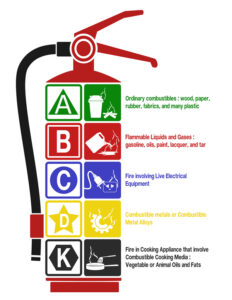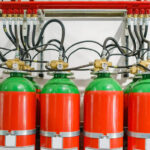According to the US Fire Administration (USFA), there were 1,291,500 fire incidences in the country in 2019. These fires led to 3,704 deaths, 16,600 injuries, and losses amounting to 14.8 billion US dollars. Fires are typically classified according to the type of fuel that feeds them. One of the most dangerous and stubborn fires to combat is the Class K fire, common in commercial kitchens. These fires can only be fought effectively with a unique extinguishing agent found in a Class K type of fire extinguisher.
What is a Class K Fire Extinguisher?
Fire extinguishers are classified depending on the type of fire that they will extinguish. A class K fire extinguisher is used to control fires involving cooking media such as oils, fats, and grease commonly found in cooking places such as commercial restaurants.These fire extinguishers work through saponification to extinguish flames completely.
What is Saponification?
Saponification is a chemical reaction that occurs when alkaline mixtures come into contact with fat or cooking oil. Ideally, the alkaline mixtures combine with the fatty acid to create a soapy foam on the surface, which effectively separates and absorbs the fire’s heat elements (the fuel, heat, and oxygen). The fire extinguisher intended for fighting a Class K fire is labeled with the letter K so users can quickly identify it during emergencies.
What Types of Extinguishers are Rated as Class K Fire Extinguishers?
Only a Class K fire extinguisher will be effective for Class K fire and must be kept within reach in a commercial kitchen setting. The right type of Class K extinguisher should effectively separate the fuel from the oxygen and adequately absorb the heat elements and smother raging kitchen fire effectively.
Currently, the only effective extinguishers rated as Class K are the Wet Chemical Fire extinguishers that meet regulatory and industry standards. The extinguishers leverage wet mist with alkaline mixtures in the form of potassium citrate, potassium acetate, or potassium carbonate. The alkaline mixture interact with cooking media to effectively quench the fire and reduce the risk of re-ignition
How to Improve Workplace Safety with Class K Fire Extinguishers?
OSHA requires commercial properties and employers to choose and distribute fire extinguishers depending on the classes of expected workplace fires. The size and degree of the hazard should also be considered when selecting a fire extinguisher.
The following are some ways to improve workplace safety with a Class K fire extinguisher:
Location
Unlike the other classes of fire extinguishers, there is no distance requirement for Class K extinguishers. According to the OSHA requirements, the extinguisher to be located at the point of anticipated cooking for ignition. However, some local requirements may be stricter, and employers should check and be familiar with their local marshal and insurance agent. In general, extinguishers in a commercial kitchen should be located as follows:
- Extinguishers should be conspicuously located and immediately available in case of fire.
- Ideal locations to place them include on hanger, cabinets, or wall recesses.
- Height requirements will depend on the weight. If it weighs less than 40 pounds, its height should not be more than 5 feet above the ground. If its weight is more than 40 pounds, it should be placed no more than 3.5 feet above the ground.
Training
For the Class K fire extinguisher to be effective during emergencies, employers should provide a suitable educational program to equip employees on the fire extinguisher’s principles and use. Ideally, OSHA recommends that the training be done during the initial hiring and once a year after that. Most types of extinguishers operate using the PASS technique:
- P- break the tamper seal by pulling the pin on the extinguisher
- A-Aim it low with the nozzle pointed at the bottom base of the fire
- S-squeeze the handle firmly to release the extinguishing agent
- S- sweep the nozzle from side to side while firmly pointing at the base of the fire until it is completely extinguished
Repeat the last three steps if the fire reignites.
Inspections
Portable fire extinguishers should be visually inspected each month. The inspection seeks to determine the following.
- If the extinguisher is appropriately located in its assigned place
- If the fire extinguishers are conspicuous and not blocked or hidden
- If the fire extinguishers are mounted following NFPA Standard No. 10 (Portable Fire Extinguishers.
- Whether the nozzles are free of any blockage and pin and seals are in place if the fire extinguisher reveal signs of abuse or damage
- Whether the pressure gauges show ideal pressure levels.
Maintenance and testing
It is the employer’s responsibility to ensure the extinguisher is maintained, inspected, and tested by a licensed expert. Maintenance should be done at least once a year or more, depending on the level e of risks. The employer should record the maintenance date and keep the records.
Why You Still Need a Fire Suppression System
Along with having a Class K fire extinguisher readily accessible, employers should have robust fire suppression systems installed within the kitchen premise. A fire suppression system is designed to detect fires at the beginning stages through heat or smoke. They are attached to an alarm system that goes off immediately the fire is detected. Most fire suppression systems automatically release extinguishing agents after detecting alerts.
 Can I Use a Class K Fire Extinguisher to Fight a class A Fire?
Can I Use a Class K Fire Extinguisher to Fight a class A Fire?
If the class K fire spreads to Class A fire materials in the kitchen, control the flames using the Class K extinguisher. However, you should not use a class A or Class B and other classes of fire extinguishers to fight a kitchen fire started by cooking media such as oil, grease, or fat.
Do You Have a Suitable Fire Extinguisher?
Fires are more likely to occur in restaurants than other types of businesses. The suitable fire extinguisher should protect your kitchen and workplace. WFX provides exceptional fire security solutions for both commercial and residential properties. Our experts will do both initial installation and routine maintenance to ensure your fire extinguishers and fire suppression systems provide adequate protection.
··· Give us a call today (855) WFX-1978 to learn what extinguishers and protection will be best for you »





